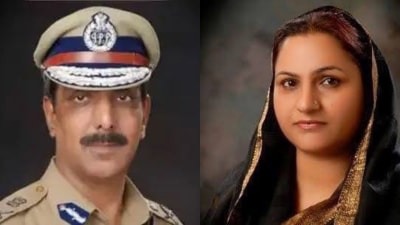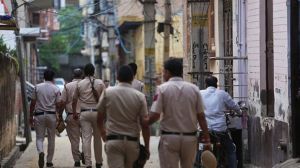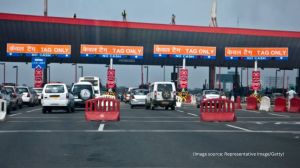Armed struggle, inspired by Mao, to topple govt?
They call it the Red Squad. And the Red Squad could have saved her husband’s life. That’s what villagers tell Rajavva when she rec...

They call it the Red Squad. And the Red Squad could have saved her husband’s life. That’s what villagers tell Rajavva when she recalls how this June, her husband Rajanna drank the pesticide he bought for their three-acre field, the crop destroyed by last year’s excess rain. And the moneylenders almost tearing his door down.
‘‘The very next day, they all came asking for their money,’’ she says, watched by her four children. ‘‘It was only then I realised why he was in such a hurry to sell the cattle we have.’’
What a pity, say her neighbours, if only the ‘‘Red Squads of the People’s War’’ had been around—Rajanna’s case would have been settled in minutes, the loan sharks would have fled, the family would have had a father this Independence Day.
In official literature, the People’s War Group is a ‘‘Left-wing extremist organisation,’’ hardly a blip on the national radar—except when they strike big. Like when the image of a blood-spattered Chandrababu Naidu—his convoy attacked by the PWG—played out on TV screens last October.
Founded in 1980 by Kondapalli Seetharamaiah who was later thrown out and died unsung, PWG cadres were weaned on the theory of Mao’s organised peasant insurrection, told to reject parliamentary democracy and aim at setting up a ‘‘people’s government’’ through ‘‘people’s war.’’ The PWG is one of a family of brothers and sisters in arms who all trace their parentage to the ‘‘peasant uprising’’ in the north Bengal village of Naxalbari under Charu Majumdar. That village gave the ‘‘struggle’’ an adjective, Naxalite. But its verb—kill and blast—cut almost crescent-like, occupying space in India’s heart of darkness.
This Naxalite belt tightens north from Andhra through the forests of eastern Maharashtra, south-east Madhya Pradesh, Chhattisgarh, Orissa, Jharkhand and Bihar before it slips into Nepal. They even have a name for it: the ‘‘Compact Revolutionary Zone that will feed the final insurrection’’ and overthrow the state.
Fanciful this may sound but on the ground it translates into a grim reality: over the last decade, an estimated 9,000 lives — of these, Andhra Pradesh alone accounts for nearly 5,000 with cadres estimating their losses at 2,000 — have been lost. That’s more lives lost than all of India’s wars put together.
To Naidu’s government, before it was swept out of power, all this was terror, no more no less. A ‘‘law and order’’ problem, so ‘‘stamping’’ it out seemed the only solution. It was another matter that no one had answers to how to stamp it out other than the Great Indian Trick of ‘‘banning’’ the organisation under POTA in 2001.
The UPA and the Y S R Reddy government have swung the other way, citing a poll promise of addressing the ‘‘socio-economic’’ Naxalite problem: POTA is on its way out, the Andhra ban on People’s War has been lifted and they are talking about talks while a ‘‘ceasefire’’ holds.
One man who will join these talks is Vara Vara Rao, who insists he’s just a ‘‘revolutionary poet’’ and not the ideologue as he’s widely projected. Ask him why this anachronism of a Left-wing guerrilla war is still on in India in 2004 and he hits the nail on its head: ‘‘The PWG is here to stay because it does not represent an immediate threat’’ to the parties in power in the affected states.
‘‘The People’s War is not asking for immediate transfer of power.’’ In fact, this is one reason, Rao says, why the new government wants to talk to them.
The PWG has extended its operations way beyond Andhra’s boundaries. It hopes to set up a ‘‘base’’ area — that stage is reached when cadres establish control over an area, different from the ‘‘primary guerrilla zone’’ where they engage the state for seizing control — in Dandakaranya stretching from Gadchiroli in eastern Maharashtra, much of Chhattisgarh to Malkangiri on Orissa’s borders with Andhra.
The People’s War general secretary is Muppala Lakshman Rao aka Ganapathi and it has a Central Committee of 21 permanent members plus six who stand in for those who can’t make it to the meetings. The People’s War also has a presence in Bihar and Jharkhand where it merged with the CPI-ML (Party Unity) in 1998. It is currently ironing out ‘‘grey areas’’ with the other main Left-wing extremist group, the Maoist Communist Centre.
There are signs that they have begun working in tandem: the Coordination Committee of Maoist Parties and Organisations of South Asia was floated in July 2001. Together with the Communist Party of Nepal (Marxists), they hope to establish a corridor stretching from the Himalayas to Dandakaranya. Between themselves, People’s War and the MCC account for more than 90 pc of Naxal violence in the country. Their theatres of operation are also those of great stagnation, both in terms of quality of life and economic growth. But that’s another story—and that’s where the story begins.
(To Be Continued)



- 01
- 02
- 03
- 04
- 05




























